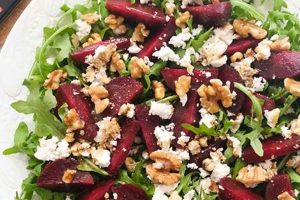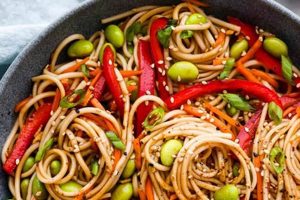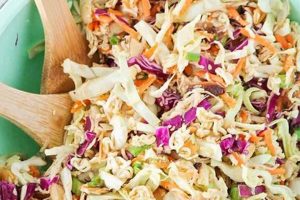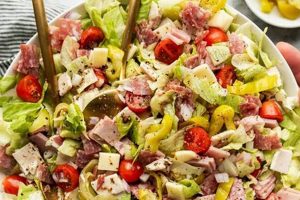A superior acini de pepe salad typically combines the small pasta shapes with creamy dressing, fruit, and sometimes other additions like marshmallows or vegetables. A good example might feature cooked acini de pepe, whipped topping, canned mandarin oranges, pineapple chunks, and maraschino cherries.
Achieving a high-quality version of this dish relies on balancing the sweetness of the fruit and other ingredients with the richness of the creamy base. Historically popular in the Intermountain West of the United States, particularly Utah and Idaho, this specific salad has become a beloved side dish for potlucks, holidays, and family gatherings. Its enduring popularity stems from its simple preparation, refreshing taste, and adaptability to various ingredient combinations.
This exploration will delve into diverse approaches to crafting this regional favorite, examining ingredient variations, optimal preparation techniques, and tips for achieving a truly exceptional culinary experience.
Tips for an Exceptional Acini de Pepe Salad
Elevating acini de pepe salad from satisfactory to exceptional involves attention to detail and thoughtful ingredient selection. These tips offer guidance for creating a truly memorable dish.
Tip 1: Pasta Perfection: Cook acini de pepe al dente. Overcooked pasta results in a mushy texture, while undercooked pasta offers an unpleasant firmness. Rinsing the cooked pasta with cold water helps stop the cooking process and maintain a desirable texture.
Tip 2: Dressing Decisions: While pre-made whipped topping offers convenience, homemade whipped cream adds a richer, more nuanced flavor. Consider incorporating cream cheese or sour cream for added tang and creaminess.
Tip 3: Fruitful Enhancements: Fresh fruit elevates the salad’s flavor profile. Experiment with seasonal options like berries or sliced grapes, alongside traditional mandarin oranges and pineapple. Ensure canned fruit is well-drained to prevent excess liquid from diluting the dressing.
Tip 4: Textural Intrigue: Toasted coconut flakes, chopped nuts, or mini marshmallows offer textural contrast and complementary flavors. Consider the overall balance of sweetness and texture when incorporating these additions.
Tip 5: Chill Out: Chilling the salad for at least two hours before serving allows the flavors to meld and enhances the refreshing quality of the dish. This also firms the dressing, contributing to a more appealing presentation.
Tip 6: Creative Customization: Don’t be afraid to experiment with different flavor combinations. A touch of citrus zest, a hint of vanilla extract, or a sprinkle of spices can add depth and complexity.
By focusing on these key aspects, one can achieve a truly exceptional acini de pepe salad, balancing texture, flavor, and visual appeal for a memorable dining experience.
By applying these insights, culinary enthusiasts can confidently create a dish that delights the palate and satisfies even the most discerning tastes.
1. High-quality acini de pepe
The foundation of an exceptional frog eye salad rests upon the selection of high-quality acini de pepe. This small, grain-shaped pasta provides the textural base for the dish, and its characteristics significantly influence the final result. Understanding the nuances of acini de pepe contributes to a more informed approach to crafting this regional specialty.
- Brand and Composition:
Different brands of acini de pepe exhibit variations in quality, affecting factors such as cooking time and texture. Semolina flour, derived from durum wheat, generally yields a firmer, more desirable texture compared to pasta made from other wheat varieties. Examining ingredient lists allows for informed choices aligned with desired outcomes.
- Cooking Technique:
Proper cooking is crucial. “Al dente” texture, achieved through careful timing and attention to the pasta’s consistency, offers the ideal balance between firmness and tenderness. Overcooking leads to a mushy texture, while undercooking results in an unpleasant firmness. Rinsing the cooked pasta with cold water halts the cooking process and maintains the desired texture.
- Visual Inspection:
High-quality acini de pepe typically presents a uniform shape and size. Avoid packages with excessive broken pieces or discoloration, which can indicate lower quality or improper storage. A visual assessment ensures the chosen pasta contributes positively to the final dish.
- Storage and Freshness:
Proper storage contributes to optimal quality. Storing dried pasta in a cool, dry place maximizes shelf life and prevents degradation. Using fresh, properly stored acini de pepe ensures the best possible texture and flavor in the finished salad.
By carefully considering these facets of acini de pepe selection, one establishes a strong foundation for a superior frog eye salad. The quality of the pasta directly impacts the overall enjoyment of the dish, influencing texture, flavor absorption, and aesthetic appeal. Attention to detail in this seemingly minor ingredient elevates the final culinary creation.
2. Creamy, flavorful dressing
The dressing serves as the unifying element in a frog eye salad, binding the pasta and other ingredients while contributing significantly to the overall flavor profile. A well-executed dressing elevates the dish from simple to exceptional. Its creamy texture provides a pleasant mouthfeel, while the flavor complements and balances the sweetness of the fruit and other components. Understanding the nuances of dressing preparation is essential for achieving a truly satisfying frog eye salad.
- Base Ingredient:
The base ingredient forms the foundation of the dressing’s texture and flavor. Traditional recipes often utilize whipped topping or whipped cream. Whipped topping offers convenience, while homemade whipped cream provides a richer flavor. Alternatives like sour cream or cream cheese introduce a tangy element and increased richness. The choice of base ingredient significantly influences the final character of the salad.
- Sweeteners:
Sweeteners contribute to the overall balance of flavors. Powdered sugar is commonly used for its ease of incorporation and smooth texture. Alternatively, granulated sugar or alternative sweeteners can be employed, though they may require additional mixing to ensure complete dissolution. The level of sweetness should complement the other ingredients, avoiding an overly saccharine taste.
- Flavor Enhancements:
Flavor enhancements add depth and complexity to the dressing. Vanilla extract is a classic addition, providing a subtle warmth. Citrus zest, such as lemon or orange, introduces a bright, refreshing note. Other options include almond extract or a touch of spice like cinnamon or nutmeg. These additions should be used judiciously to avoid overpowering the other flavors.
- Consistency and Incorporation:
Achieving the proper consistency is crucial. The dressing should be thick enough to coat the pasta and other ingredients without being overly heavy or gloppy. Careful folding or gentle mixing ensures a smooth, homogenous texture while preventing the whipped cream base from deflating. Proper incorporation of ingredients contributes to the overall appeal and enjoyment of the salad.
The dressing’s role in a frog eye salad extends beyond simply binding ingredients. It contributes significantly to the overall sensory experience, influencing texture, flavor, and enjoyment. Careful consideration of the base ingredient, sweeteners, flavor enhancements, and consistency allows for a balanced and delicious final product, essential for a truly exceptional frog eye salad. The delicate interplay between these elements determines the ultimate success of the dish, making the dressing a crucial component of any “best” recipe.
3. Fresh, balanced fruit
Fruit selection significantly impacts the quality of a frog eye salad. While traditional recipes often incorporate canned fruits like mandarin oranges and pineapple, the inclusion of fresh fruit elevates the dish through enhanced flavor and textural complexity. The balance between sweetness and acidity plays a crucial role in achieving a harmonious flavor profile. Overly sweet fruit can create an unbalanced dessert-like quality, while insufficient sweetness diminishes the refreshing character of the salad. Consider the interplay of different fruits. For instance, the tartness of fresh berries complements the sweetness of pineapple, while the juicy brightness of grapes contrasts with the creamy richness of the dressing.
The quality and ripeness of the fruit directly influence the overall taste experience. Using perfectly ripe, in-season fruit maximizes flavor intensity and contributes to a more vibrant salad. Conversely, underripe or overripe fruit can detract from the desired taste and texture. Practical considerations include proper storage of fresh fruit to maintain optimal quality and prevent spoilage. Washing and preparing fruit just before incorporating it into the salad ensures peak freshness and minimizes oxidation. Furthermore, attention to detail, such as removing any blemishes or bruises, enhances the visual appeal of the finished dish. These practices contribute to the overall culinary experience, underscoring the importance of fresh, balanced fruit in crafting a superior frog eye salad.
Balancing flavor profiles and textures through strategic fruit selection contributes to the overall complexity and enjoyment of frog eye salad. Fresh fruit, when carefully chosen and prepared, offers a superior sensory experience compared to canned alternatives. This understanding enables informed decision-making regarding fruit selection, preparation, and incorporation, ultimately leading to a more satisfying culinary outcome. The interplay between fruit and other components, such as the dressing and textural elements, highlights the crucial role fresh fruit plays in achieving a truly exceptional frog eye salad.
4. Complementary textural elements
Textural contrast contributes significantly to a “best” frog eye salad recipe, elevating it beyond a simple combination of ingredients. A successful recipe balances the soft, creamy texture of the pasta and dressing with contrasting elements that provide textural intrigue. This interplay of textures creates a more engaging and satisfying sensory experience.
- Nuts:
Chopped nuts, such as almonds, pecans, or walnuts, introduce a satisfying crunch and subtle nuttiness. Toasted nuts further enhance their flavor and provide a deeper level of textural contrast. The choice of nut should complement the other flavors in the salad, considering factors like sweetness and intensity.
- Seeds:
Sunflower seeds, pumpkin seeds, or poppy seeds offer a more delicate crunch than nuts. Their smaller size allows for even distribution throughout the salad. Seeds can contribute additional nutritional value while enhancing textural diversity.
- Coconut:
Shredded or flaked coconut, especially when toasted, provides a distinctly sweet and chewy texture. The toasting process intensifies the coconut flavor and creates a crisp exterior. Coconut pairs well with the traditional fruit components of the salad.
- Miniature Marshmallows:
Miniature marshmallows contribute a soft, airy texture that contrasts with the creaminess of the dressing and the potential crunch of nuts or seeds. They also enhance the sweetness of the salad. The quantity of marshmallows should be balanced to prevent overwhelming the other flavors and textures.
The strategic incorporation of these textural elements elevates the frog eye salad from agreeable to exceptional. Consideration of flavor profiles, size, and overall balance ensures a harmonious blend of textures that enhance the dining experience. The interplay of soft, creamy, crunchy, and chewy elements creates a dynamic and satisfying culinary creation. A truly “best” frog eye salad recipe utilizes these contrasting textures to create a memorable dish.
5. Proper Chilling Time
Chilling time plays a crucial role in achieving a “best” frog eye salad recipe. Adequate refrigeration allows flavors to meld and textures to optimally develop, contributing significantly to the overall sensory experience. Understanding the impact of chilling time is essential for creating a superior dish.
- Flavor Development:
Chilling allows the diverse flavors of the salad componentspasta, dressing, fruit, and any additional textural elementsto meld and harmonize. The absorption of flavors by the pasta creates a more cohesive and nuanced taste profile. This fusion of flavors is essential for a well-balanced and enjoyable salad.
- Texture Enhancement:
Refrigeration firms the dressing, preventing it from becoming runny and ensuring a pleasant mouthfeel. The chilling process also affects the pasta’s texture, enhancing its firmness and preventing it from becoming mushy. This improvement in texture contributes to a more appealing and satisfying dining experience.
- Temperature and Palatability:
A chilled salad offers a refreshing contrast, particularly when served during warmer weather. The cool temperature enhances the sweetness of the fruit and the creaminess of the dressing, creating a more balanced and enjoyable sensory experience. A properly chilled salad is more palatable and refreshing than one served at room temperature.
- Optimal Chilling Duration:
While the specific chilling time can vary depending on the recipe and individual preferences, a general guideline is to refrigerate the salad for at least two hours before serving. This duration allows sufficient time for flavor development and texture enhancement without compromising the quality of the ingredients. Extended chilling, while generally acceptable, may not yield significant further improvements and could potentially affect the texture of some ingredients over time.
Proper chilling is not merely a final step but an integral part of crafting the best frog eye salad. The chilling process enhances flavor development, texture, and overall palatability, contributing significantly to the dish’s success. A “best” recipe recognizes the importance of this often-overlooked element and incorporates it strategically to achieve optimal results. The attention to chilling time distinguishes a truly exceptional frog eye salad from a merely satisfactory one.
6. Creative Flavor Enhancements
Creative flavor enhancements distinguish exceptional frog eye salad recipes from standard versions. These enhancements move beyond basic ingredients, adding depth and complexity that elevate the overall sensory experience. The thoughtful incorporation of nuanced flavors transforms a familiar dish into a culinary delight. Flavor enhancements, while seemingly minor, contribute significantly to achieving a “best” recipe designation.
Several avenues exist for creative flavor enhancement. Extracts, such as vanilla, almond, or peppermint, introduce distinct aromatic notes that complement the sweetness of the fruit and creaminess of the dressing. Zests, derived from citrus fruits like lemon, orange, or lime, offer a bright, refreshing counterpoint to the richer elements. Spices, used judiciously, add warmth and complexity; options include cinnamon, nutmeg, or cardamom. Incorporating fresh herbs, like mint or basil, provides a refreshing herbal counterpoint. For example, a hint of orange zest can brighten the overall flavor profile, while a touch of cardamom can add unexpected warmth. The key lies in balance and restraint, ensuring that enhancements complement rather than overpower the existing flavors. These additions create a layered flavor profile that elevates the dish beyond the ordinary.
The practical significance of creative flavor enhancements lies in their ability to transform a familiar dish into a unique culinary experience. These enhancements demonstrate culinary expertise and attention to detail. Careful consideration of flavor pairings and the interplay of ingredients allows for a customized and memorable frog eye salad. A “best” recipe leverages these subtle yet impactful additions to achieve a superior result, demonstrating a deep understanding of flavor dynamics and the potential for culinary creativity. The ability to effectively incorporate creative flavor enhancements distinguishes truly exceptional frog eye salads.
Frequently Asked Questions
This section addresses common inquiries regarding optimal frog eye salad (specifically using acini de pepe pasta) preparation, offering clarity and guidance for achieving exceptional results.
Question 1: What is the ideal cooking time for acini de pepe to prevent a mushy texture?
Acini de pepe should be cooked al dente, typically 7-9 minutes, but always refer to package directions. Testing for doneness by biting into a piece ensures the desired firmness. Immediately rinsing with cold water halts the cooking process and prevents overcooking.
Question 2: Can fresh fruit be substituted for canned fruit in this recipe?
Fresh fruit enhances flavor and texture. While canned fruit offers convenience, fresh alternatives, such as pineapple, mandarin oranges, grapes, or berries, elevate the overall quality. Ensure fresh fruit is ripe and properly prepared.
Question 3: What can be used as a substitute for whipped topping if a richer flavor is desired?
Homemade whipped cream offers a richer flavor profile compared to whipped topping. Alternatively, blending cream cheese or sour cream into whipped topping enhances creaminess and tang.
Question 4: How long should frog eye salad be chilled before serving?
Chilling for at least two hours allows flavors to meld and enhances the salad’s refreshing quality. Extended chilling is acceptable, but avoid excessive durations that may affect texture.
Question 5: What are some suitable textural additions to enhance the salad’s complexity?
Toasted nuts (almonds, pecans), seeds (sunflower, poppy), toasted coconut flakes, or miniature marshmallows provide contrasting textures. Balance these additions to complement the other ingredients.
Question 6: How can one prevent the dressing from becoming too thin or watery?
Ensure canned fruit is well-drained to prevent excess liquid. Using high-quality whipped topping or homemade whipped cream, and chilling adequately, helps maintain the dressing’s desired consistency. Avoid overmixing, which can deflate whipped cream.
Careful attention to these details ensures a successful and enjoyable frog eye salad experience. Understanding these nuances allows for informed choices and optimized preparation techniques, leading to a dish that meets the highest standards.
By understanding these common inquiries, individuals can approach frog eye salad preparation with confidence, equipped to address potential challenges and create a truly exceptional dish.
Crafting the Best Frog Eye Salad
Exploration of optimal acini de pepe salad preparation reveals that achieving excellence hinges on several key factors. High-quality pasta, cooked al dente, forms the foundation. A creamy, flavorful dressing, whether classic whipped topping or a richer homemade version, binds the ingredients and provides a balanced sweetness. Fresh, carefully selected fruit contributes vibrant flavor and textural complexity. Complementary textural elements, such as toasted nuts or coconut, offer contrasting sensations. Adequate chilling allows flavors to meld and textures to set. Finally, creative flavor enhancements, like citrus zest or spices, elevate the dish from simple to exceptional. Each component contributes to the overall sensory experience, underscoring the importance of a holistic approach.
Culinary success with this regional favorite rests on a nuanced understanding of these interconnected elements. Through thoughtful ingredient selection, precise preparation techniques, and attention to detail, one transforms basic components into a truly memorable culinary creation. The pursuit of a “best” acini de pepe salad recipe represents a journey of culinary discovery, offering opportunities for experimentation and personalized expression. This ongoing exploration enriches culinary traditions and underscores the enduring appeal of this beloved dish.






